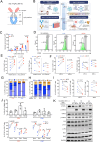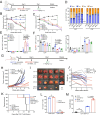rhIL-7-hyFc, a long-acting interleukin-7, improves efficacy of CAR-T cell therapy in solid tumors
- PMID: 39043602
- PMCID: PMC11268061
- DOI: 10.1136/jitc-2024-008989
rhIL-7-hyFc, a long-acting interleukin-7, improves efficacy of CAR-T cell therapy in solid tumors
Erratum in
-
Correction: rhIL-7-hyFc, a long-acting interleukin-7, improves efficacy of CAR-T cell therapy in solid tumors.J Immunother Cancer. 2025 Mar 5;13(3):e008989corr1. doi: 10.1136/jitc-2024-008989corr1. J Immunother Cancer. 2025. PMID: 40044580 Free PMC article. No abstract available.
Abstract
Background: Chimeric antigen receptor T-cell (CAR-T) therapy has achieved remarkable remission in patients with B-cell malignancies. However, its efficacy in treating solid tumors remains limited. Here, we investigated a combination therapy approach using an engineered long-acting interleukin (IL)-7 (rhIL-7-hyFc or NT-I7) and CAR-T cells targeting three antigens, glypican-2 (GPC2), glypican-3 (GPC3), and mesothelin (MSLN), against multiple solid tumor types including liver cancer, neuroblastoma, ovarian cancer, and pancreatic cancer in mice.
Methods: CAR-T cells targeting GPC2, GPC3, and MSLN were used in combination with NT-I7 to assess the anticancer activity. Xenograft tumor models, including the liver cancer orthotopic model, were established using NOD scid gamma mice engrafted with cell lines derived from hepatocellular carcinoma, neuroblastoma, ovarian cancer, and pancreatic cancer. The mice were monitored by bioluminescence in vivo tumor imaging and tumor volume measurement using a caliper. Immunophenotyping of CAR-T cells on NT-I7 stimulation was evaluated for memory markers, exhaust markers, and T-cell signaling molecules by flow cytometry and western blotting.
Results: Compared with the IL-2 combination, preclinical evaluation of NT-I7 exhibited regression of solid tumors via enhanced occupancy of CD4+ CAR-T, improved T-cell expansion, reduced exhaustion markers (programmed cell death protein 1 or PD-1 and lymphocyte-activation gene 3 or LAG-3) expression, and increased generation of stem cell-like memory CAR-T cells. The STAT5 pathway was demonstrated to be downstream of NT-I7 signaling, mediated by increased expression of the IL-7 receptor expression in CAR-T cells. Furthermore, CAR-T cells improved efficacy against tumors with low antigen density when combined with NT-I7 in mice, presenting an avenue for patients with heterogeneous antigenic profiles.
Conclusion: This study provides a rationale for NT-I7 plus CAR-T cell combination therapy for solid tumors in humans.
Keywords: Adoptive cell therapy - ACT; Chimeric antigen receptor - CAR; Hepatocellular Carcinoma; Monoclonal antibody; Solid tumor.
© Author(s) (or their employer(s)) 2024. Re-use permitted under CC BY-NC. No commercial re-use. See rights and permissions. Published by BMJ.
Conflict of interest statement
Competing interests: MH and DL are inventors on the related patent application no. 63/196556 assigned to the NIH, “Combination immunotherapy for the treatment of glypican-3 (GPC3)-expressing tumors”. MH and DL have patents related to antibody and cell-based immunotherapies and may receive blind royalties from the NIH. MH received research funds from NeoImmuneTech via Cooperative Research and Development Agreement (CRADA) assigned to the NIH. AW, SF-M, and BHL are employees of NeoImmuneTech. The authors declare no other conflicts of interest.
Figures







References
-
- Thistlethwaite FC, Gilham DE, Guest RD, et al. The clinical efficacy of first-generation carcinoembryonic antigen (CEACAM5)-specific CAR T cells is limited by poor persistence and transient pre-conditioning-dependent respiratory toxicity. Cancer Immunol Immunother. 2017;66:1425–36. doi: 10.1007/s00262-017-2034-7. - DOI - PMC - PubMed
MeSH terms
Substances
Grants and funding
LinkOut - more resources
Full Text Sources
Research Materials
Miscellaneous
